The guys behind South Park have been refreshingly upfront about their indebtedness to previous artists. While they’re not unique in that, I can’t think of another cartoon that has devoted an entire episode to their own anxiety of influence. That’s why I believe they won’t be too upset with me for pointing out that they ripped off one of their more famous scenes from a 700-year-old manuscript:
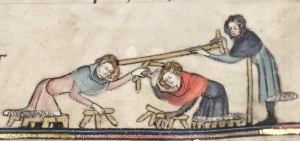
Once again, I find myself featuring an image found in the Bodleian Alexander (MS Bodl. 264), an early fourteenth-century deluxe manuscript so lavishly illuminated it could support a blog all on its own. ((Some might say, given its frequent appearances here, that it already does.)) The subject? A gentleman’s dispute among disabled beggars. Or, as Matt Stone and Trey Parker put it some ten years back, ((Good god I’m old. When exactly did South Park cross the threshold into venerable institution?)) a cripple fight. ((A phrase which probably should be capitalized to simulate a fifth grader’s gleeful bellow and followed by many exclamation points. Precisely how many I leave to the discretion of the reader.)) I feel compelled to point out–with some weird version of disciplinary pride?–that the medieval manuscript version of the theme boats three brawlin’ beggars to the cartoon’s two, a net improvement of fifty percent over South Park. And it’s way bloodier than they dared, to boot (which you can see more clearly if you click to expand).
I realize that some of my readers might blanch at my casual usage of a South Parkian coinage that could very well offend, and for that I apologize and beg exemption from your scorn under the aegis of direct quotation. But if you don’t buy that, maybe I can ply you with some pretty pictures? The scuffling scabellarii ((A word I learned today that means ‘people with disabled legs who have to use stools (scabella) to get around’. One more for the wordhoard.)) above are found in the section of the Alexander MS illuminated by the master artist on the project, and one of his signature flourishes was birds. Lots, and lots, and lots of pretty chirpy birds roosting and flying and perching all over the place. Just zoom out a touch from the offending tableau, and there they are (the lower one, sadly, smeared by the years):
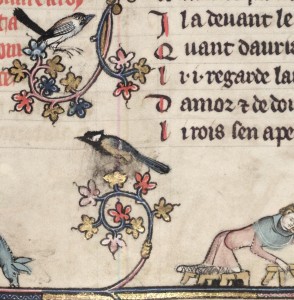
There’s another looking down from the ascending foliate border that the combatants war upon:
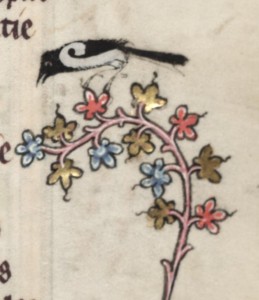
And one in the border in the page’s middle margin:
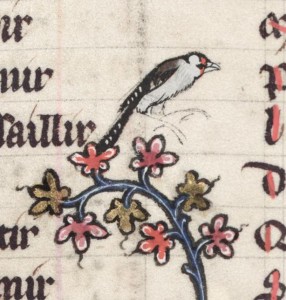
An still another tucked in beside the mildler marginal image to the combatants’ left, a one man hay ride:
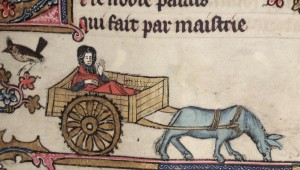
All told, there’s hundreds of little birds peppered throughout this artist’s section of the book, no two exactly the same, all patterned, or so I’m told, after actual species, not invented. He must have been quite the naturalist.
And since I so rarely do this, it might help to see the entire page at once. Though keep in mind, the real manuscript wouldn’t fit on your monitor, being something like 50cm x 65cm (a foot and a half tall by two feet across) when fully opened. This is just half of a two-page spread: ((And, no, I didn’t miss the birdy in the far right corner. He’s just a little too faded to feature.))
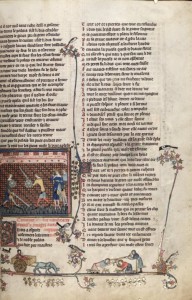
In the end, the nice thing about medieval manuscripts is that if one image offends, we have but to follow Chaucer’s advice to “turn over the leaf and choose another” and the artist will usually reward us for our indulgence. With a book as grand as the Bodleian Alexander, we don’t even have to leave the leaf.

